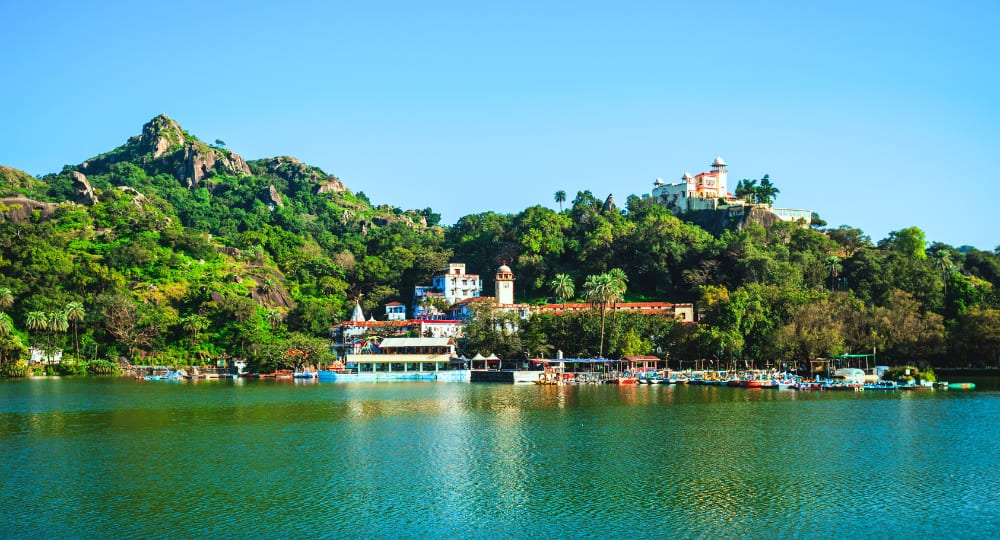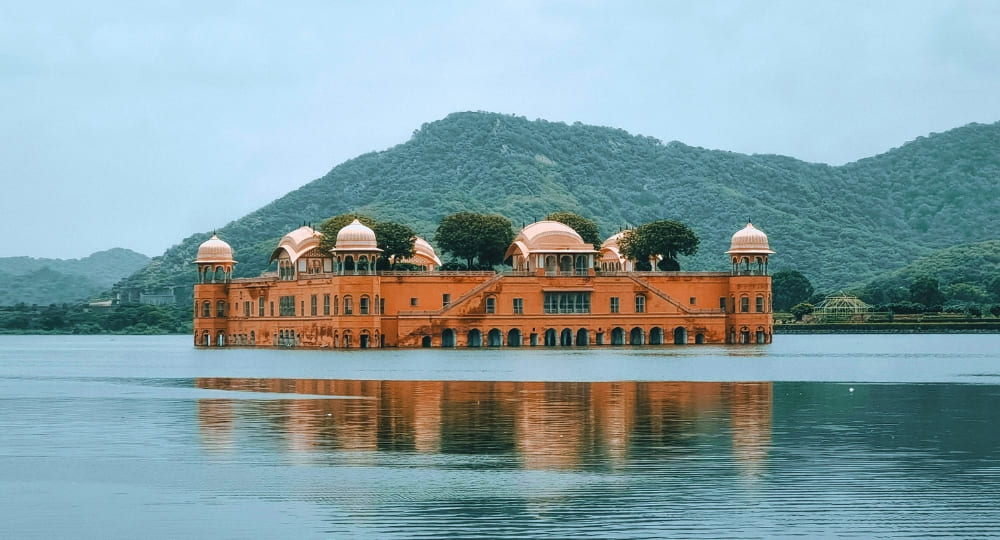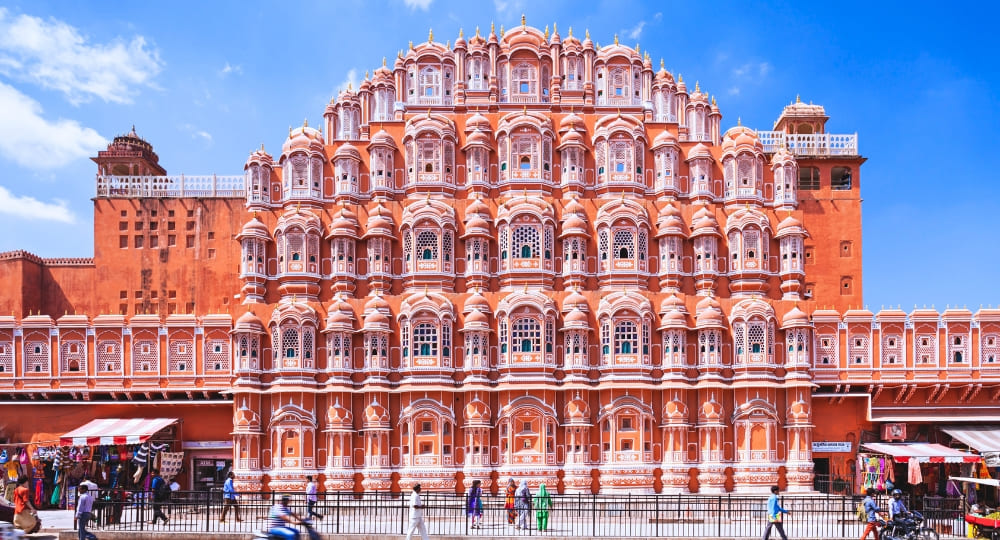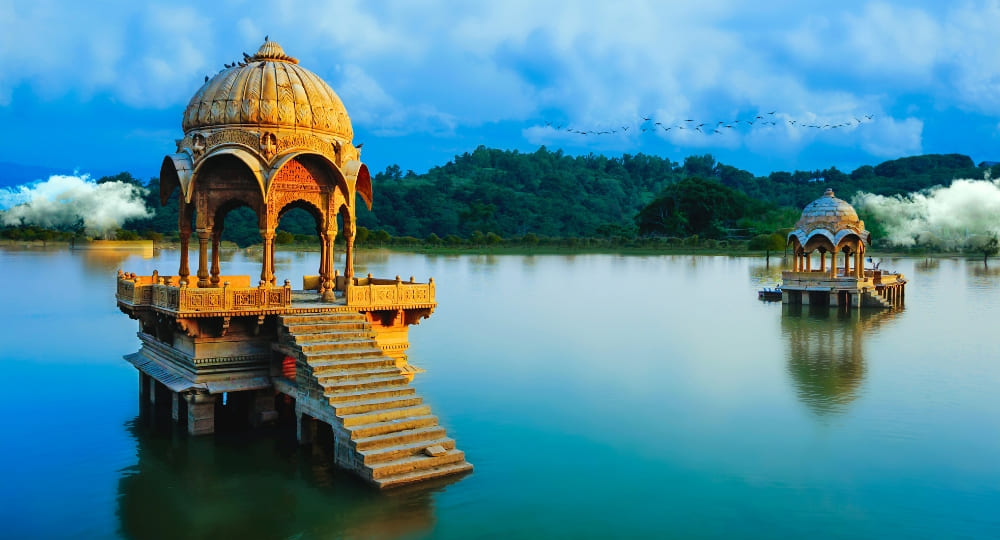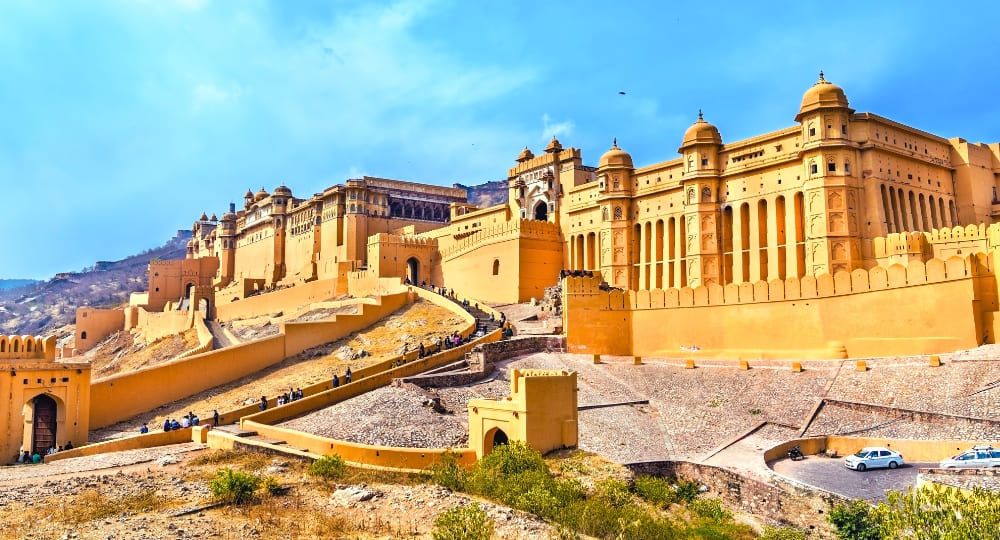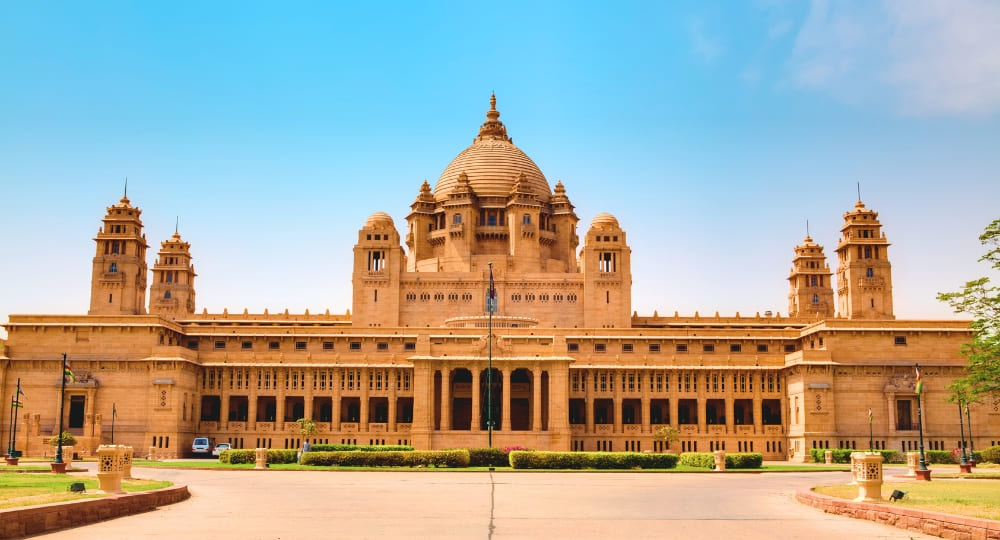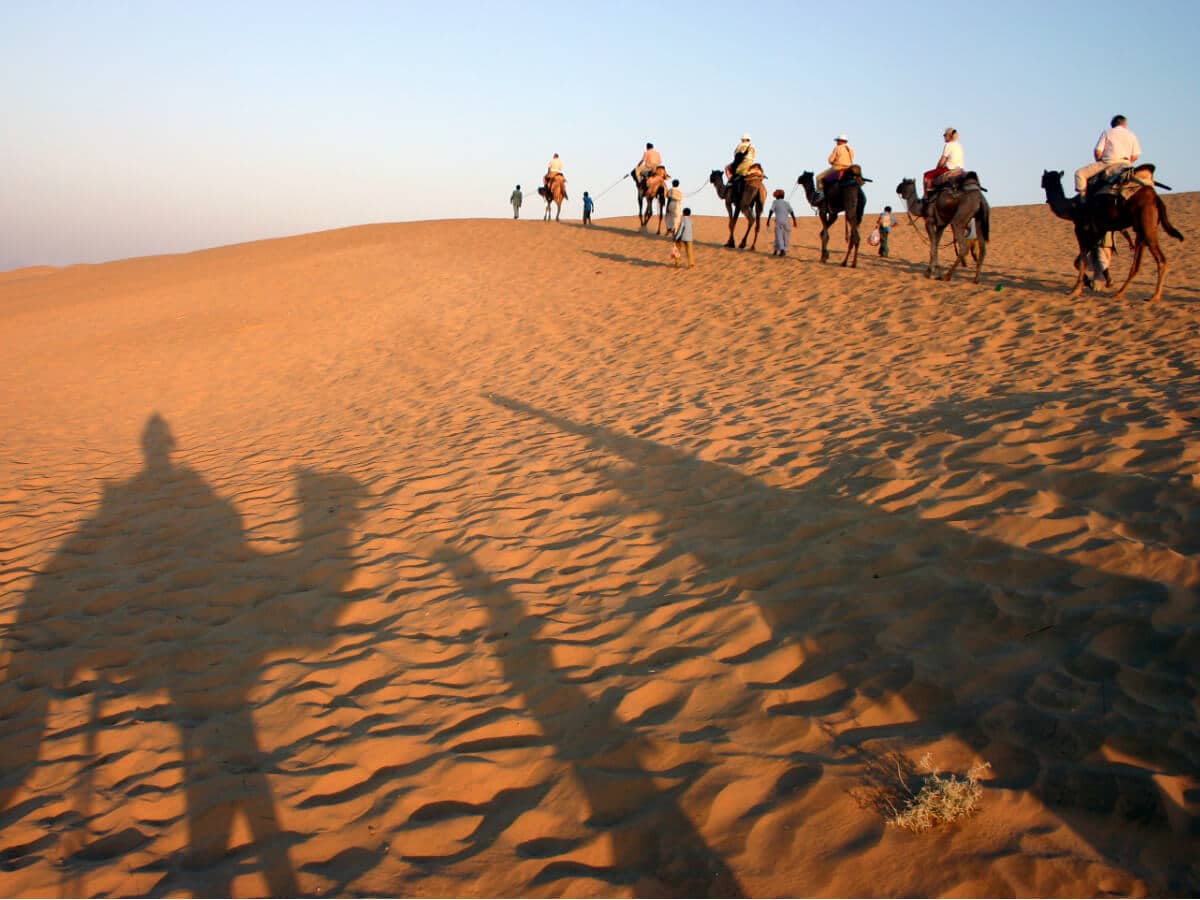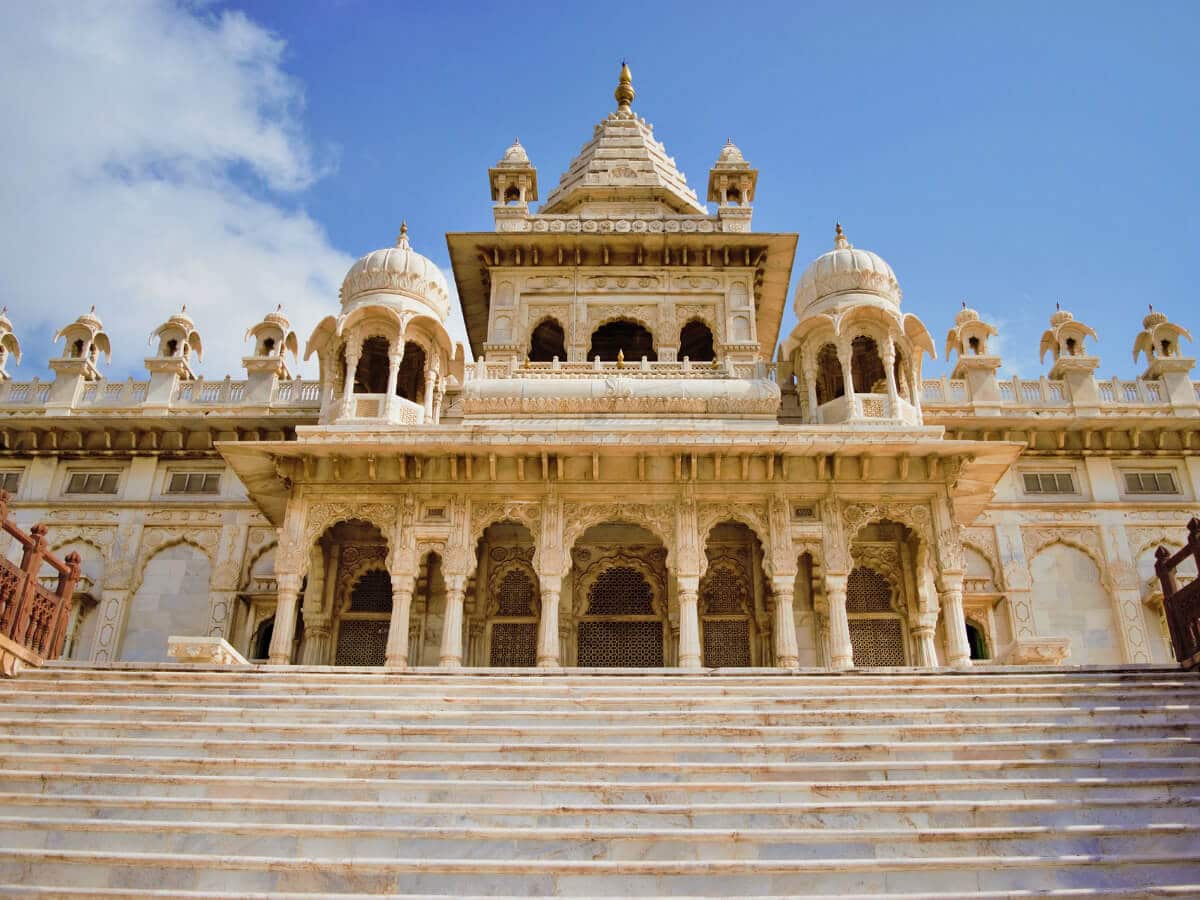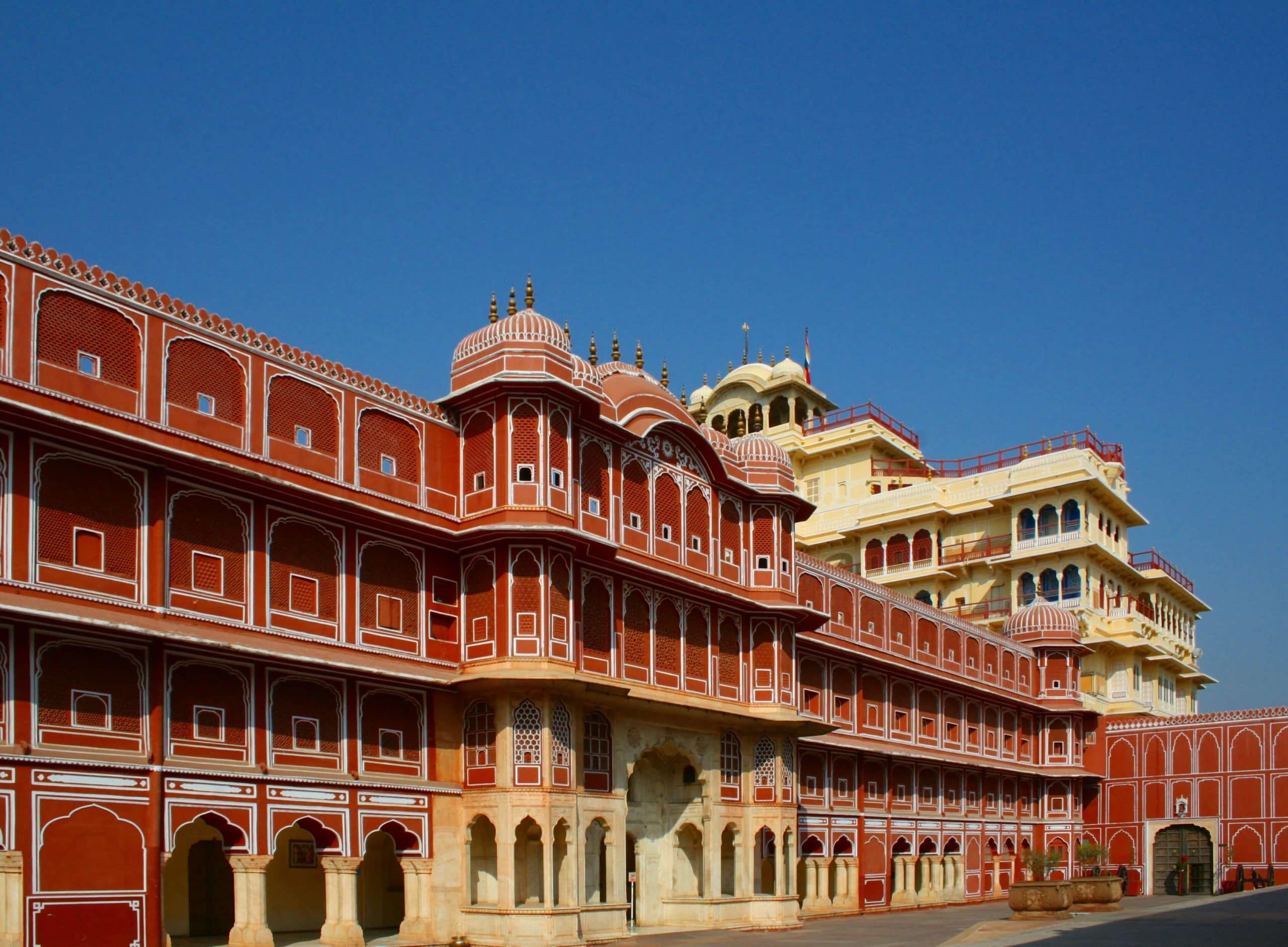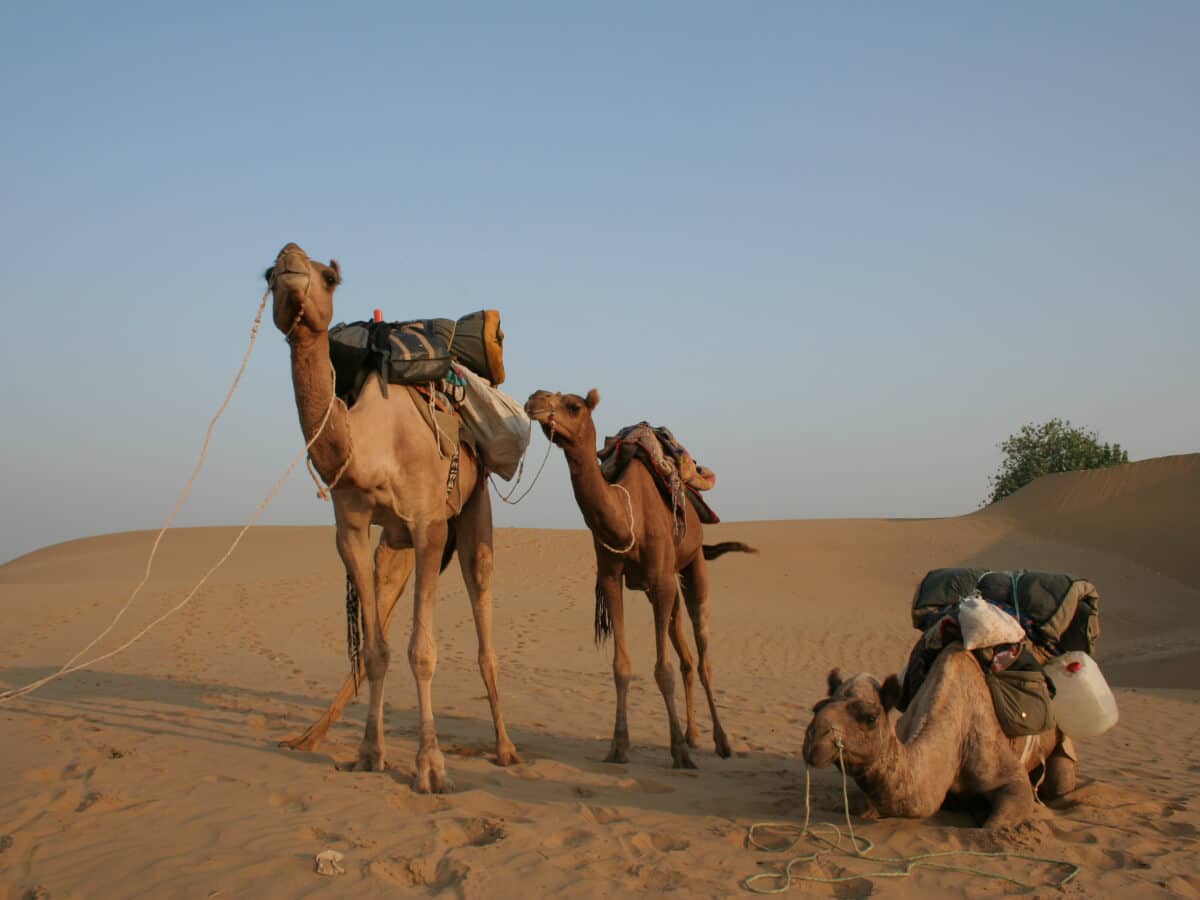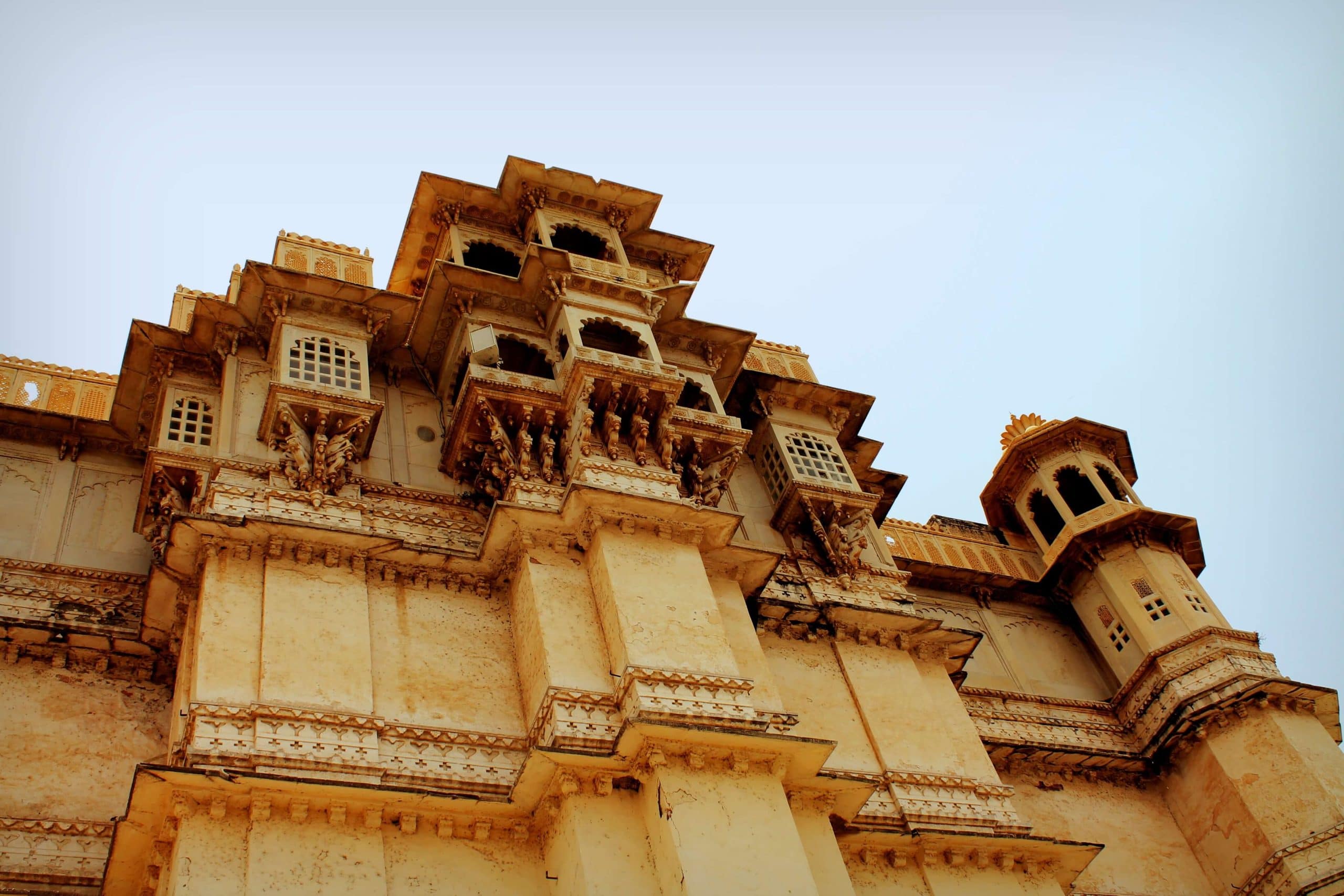Tour Packages
Rajasthan Tour Packages
SUPER DEAL PRICE
STARTS FROM
per person on twin sharing
Kumbhalgarh Fort has the world’s second-longest wall.

Thar Desert stands as India’s largest hot desert.

Mehrangarh Fort is among India’s largest forts.

Pushkar Mela is the world’s largest camel fair.
Shekhawati Region has India’s largest fresco havelis.
Rajasthan Overview
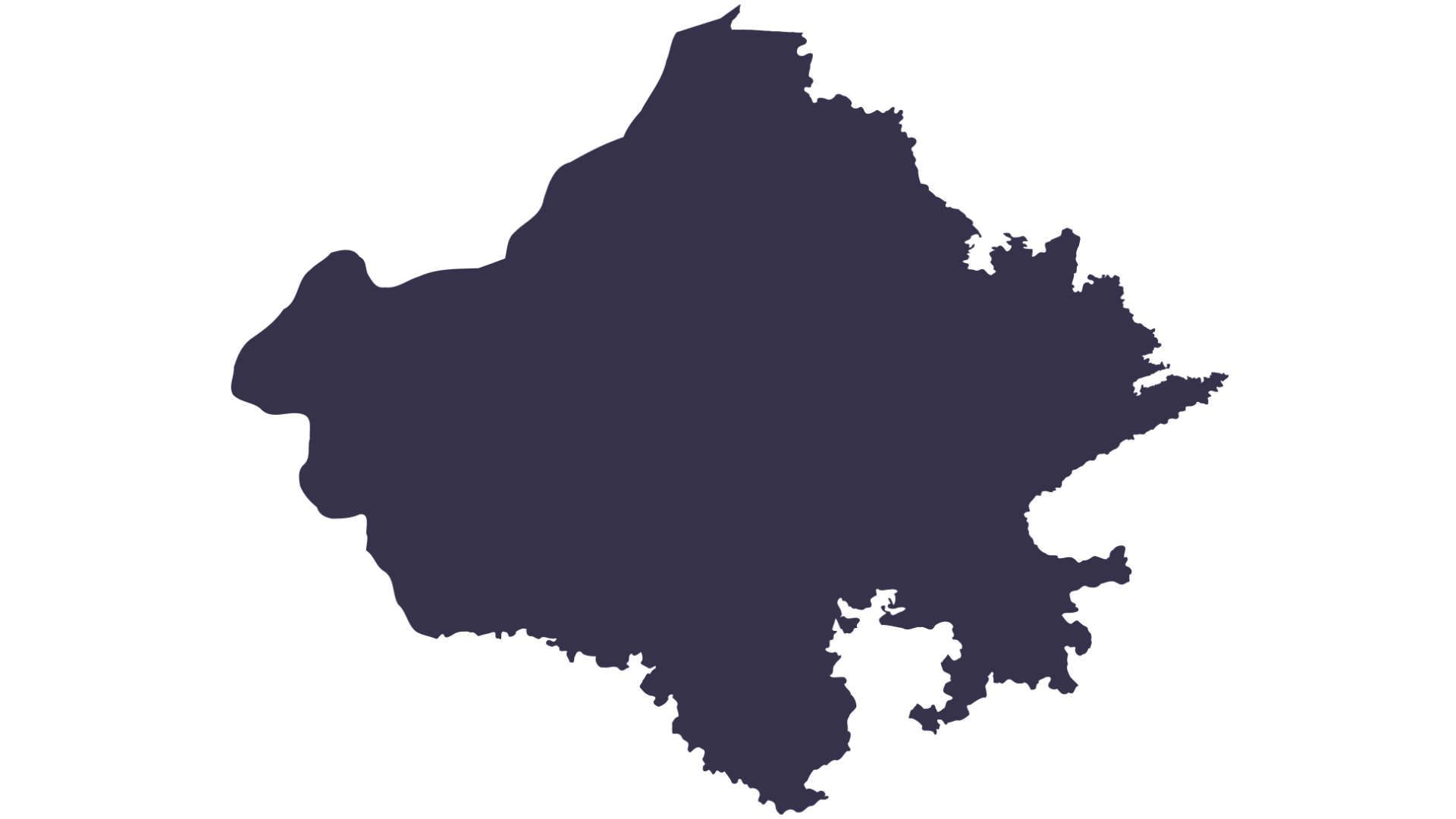
By Purpose
Couples
For Newlywed Vacations
Family
For Family Vacations
Colourful Cities
Pink City: Jaipur
Blue City: Jodhpur
Red City: Bikaner
Golden City: Jaisalmer
White City: Udaipur
Top Attractions
Hawa Mahal
Lake Palace
Amer Fort
Pushkar Lake
Mount Abu
City Palace
Rao Jodha Desert Park
Chittorgarh Fort
Mehrangarh Fort
Jaisalmer Fort
Everything You Need to Know About Rajasthan
With its forts, colourful cities, havelis, and colourful trinkets, Rajasthan is a treasure trove of history and culture. True to its name, Rajasthan is indeed the Land of Kings, where guests are treated with warmth and respect and treated like royalty. They truly embody the phrase Atithi Devo Bhava, a principle where guests are equated to God. If you’d like to explore this fascinating state and learn more about its art, architecture, cuisine, festivals, and its people, check GT Holidays’ Rajasthan tour packages.
We can also arrange curated Rajasthan tour packages where you get to pick and choose your experiences. Call or send a message on Instagram to learn more.
Table of Content:
- About Rajasthan
- Tidbits
- Essential Tips To Know When Choosing Rajasthan Tour Packages
- Top Reasons To Choose Rajasthan Tour Packages
- Best Time To Choose Rajasthan Tour Packages
- Top Cities Included In Your Rajasthan Tour Packages
- Top Tourist Attractions In Rajasthan
- Top Experiences In Your Rajasthan Tour Packages
- Shopping
- Dos and Don’ts of Visiting Rajasthan
- Food
- Arts and Crafts
About Rajasthan
Situated in India’s northwest corner, Rajasthan was once a confederation of several princely states ruled by Rajput families. Before 1949, the region was called Rajputana, and later came to be known as Rajasthan Union and Greater Rajasthan. Today, Rajasthan is India’s largest state and one of the world’s premier venues for destination weddings.
If you’d like to say ‘I Do’ amidst the royal palaces of Rajasthan, call us to learn more about our destination wedding packages. We can also arrange customised Rajasthan tour packages to match your style and budget.
History
Some of the earliest settlements in Rajasthan date back to the Stone Age. The region is also home to several Indus Valley Civilisation sites, including Kalibangan in the Ghaggar Valley. Saraswati, the ancient Vedic River, is believed to have once flowed through Rajasthan. It was also mentioned in the Ramayana and Mahabharata epics, with territories around Alwar and north Rajasthan mentioned as the kingdoms of Shalva, Madra, and Jangala.
During the medieval period from the 7th to the 12th century, several Rajputs established kingdoms. For instance, Rao Siha established the Kingdom of Marwar in the 13th century, while Bappa Rawal founded the Mewar Dynasty in the 8th century. These kings not only protected their territories from other Rajput kings but also from invading armies from Afghanistan and Central Asia.
The later Rajput kings formed alliances with the Mughals and later the British, signing treaties to consolidate the region into the Rajputana Province.
Geography
While the Thar covers almost 60% of Rajasthan, the state isn’t all about desert landscape. The Aravalli range runs from southwest to northeast, dividing the state into eastern and western regions. The eastern plains are fertile thanks to the erosion of the Aravalli range and the presence of the Banas and Chambal rivers. The western region is dry and home to the Thar Desert. The climate of Rajasthan is arid and semi-arid with scorching summers and cold winters.
Economy
Rajasthan is a mineral-rich state and the country’s primary source of marble, limestone, and sandstone. There are large deposits of zinc, copper, gypsum, lignite, and mica. Agriculture is a prime industry in the state, with millets like bajra, jowar, and maize being its main produce. Rajasthan is also an important producer of oil seeds, pulses, and spices like cumin, coriander, fenugreek, fennel, and ajwain.
To explore the region’s diverse culture and heritage, check our Rajasthan tour packages.
Tidbits
- Rajasthan is home to the Karni Mata Mandir, a temple where rats are revered.
- Kumbhalgarh Fort is the world’s second-longest continuous wall, stretching over 36 km.
- The Om Banna Temple in Pali is dedicated to an old 350 cc Royal Enfield.
- The Kuldhara village is a ghost town that was abandoned over 200 years ago and is believed to be haunted.
- Rajasthan is home to several Indus Valley Civilisation sites.
- The Bramha Temple in Pushkar is one of the few places (and the oldest) dedicated to Lord Brahma and his consort Gayatri Devi.
- It is the largest state in India by area, covering over 342,239 sq km.
Over 60% of Rajasthan is desert. - Most Rajasthani cities get their name from their founders. (Jai Singh – Jaipur, Jodhpur – Rao Jodha, Bikaner – Rao Bika)
- Jaipur was painted pink to welcome Prince Edward, Prince of Wales.
Essential Tips To Know When Choosing Rajasthan Tour Packages
- Rajasthan is very diverse – choose Rajasthan tour packages depending on your preferences.
- Ask for permission before taking photos of people, especially women in rural areas.
- Pack sunscreen lotion and a wide-brim hat, irrespective of the season.
- Don’t forget to pack mosquito repellents and medications.
- Travel with an open mind when visiting the state – Rajasthani culture is very different and unique.
- If you’re travelling from another country, check with your government about mandatory vaccinations.
- Rajasthan is a conservative place – make sure you carry modest clothes, especially for temple visits.
Top Reasons To Choose Rajasthan Tour Packages
Colourful Cities
The colour-related nicknames of several Rajasthani cities aren’t random; instead, they carry significant historical and cultural meaning. Rajasthan’s capital city, Jaipur, is nicknamed the Pink City, as the erstwhile Maharaja Sawai Ram Singh II had the city’s buildings painted in pink hues (symbolising hospitality) to welcome Prince Albert Edward of Wales. He even went a step further and passed a law requiring all buildings in Old Jaipur to be painted in Jaipur Pink. The law remains in effect to this day.
Udaipur is fondly known as the White City due to the numerous marble buildings that adorn the city.
Jodhpur is known as the Blue City due to the numerous blue-hued houses that dot its landscape. There are several theories as to why the houses in Jodhpur are painted blue. Some believe it indicates the homes and social status of Brahmins, while others claim that blue helps keep their houses cool. Some believe that blue prevents termite infestation, while some people believe that blue represents Lord Shiva.
Bikaner is nicknamed the Red City because of the reddish hues of the many havelis in the old town.
Jaisalmer is known as the Golden City due to the sandstone buildings that glisten in the sun, emitting a golden hue that contributes to its nickname.
Jhalawar is known as the Purple City due to the homes that are coloured purple. This less-explored city is definitely worth visiting, thanks to its numerous forts and temples.
Historic Forts
Unsurprisingly, Rajasthan is home to hundreds of forts, palaces, and havelis, given that the state is often referred to as the Land of Kings. The hill forts of Chittorgarh, Kumbhalgarh, Sawai Madhopur, Jhalawar, Jaipur, and Jaisalmer are collectively listed as UNESCO World Heritage sites because of their historical significance and architectural beauty.
The Mehrangarh Fort in Jodhpur is renowned for its intricately carved palaces, including the Sheesh Mahal, Phool Mahal, and Moti Mahal, as well as the museum that houses invaluable artefacts of the royal family.
The Umaid Bhawan Palace in Jodhpur is now the largest private residence in the world, housing a luxurious heritage hotel and a museum that showcases the royal family’s vast treasures.
The Jal Mahal was built in the 18th century in the middle of the Mansagar Lake.
Hawa Mahal in Jaipur is famous for its iconic honeycomb windows.
Neemrana Fort in Alwar is a heritage hotel and showcases impressive Rajput architecture.
Besides the numerous palaces and forts, Rajasthan is also renowned for its havelis, such as the Rampuria havelis in Bikaner and the Nathmal Ji Ki Haveli in Jaisalmer.
Architectural Marvels
Rajasthani architecture is a seamless blend of Rajput, Mughal, and Hindu architectural styles. These are reflected through its forts, palaces, havelis, temples, stepwells, and even museums.
The Jantar Mantar, built by Maharaja Jai Singh II, reflects India’s rich history in astronomy and engineering. It also features the Samrat Yantra, the world’s largest sundial.
Similarly, Hawa Mahal, built in red and pink sandstone, features stunning latticework.
The Ranakpur Temple in Bikaner features over 1,444 exquisite carvings, domes, and pillars that represent core Jain principles, such as ahimsa and satya.
The Dilwara Temples in Mount Abu are built in the Maru-Gurjar style and are famous for their exquisite marble architecture and intricate carvings.
Some of the elements of Rajasthani architecture that stand out include the use of intricate jaali work or latticework, chattris or domes, intricate stone carvings, and expansive courtyards.
Call us at +91 9940882200 to learn more about GT Holidays’ Rajasthan tour packages.
Dance & Music
You cannot explore Rajasthan without appreciating its lively folk dances and music performances. Your evenings will almost always end with a performance by Rajasthani folk artists wearing colourful costumes that stand in stark contrast to the region’s desert landscape.
Ghoomar, a Rajasthani folk dance, features women wearing long, flowing skirts and gracefully swirling to the rhythm of folk music.
Kachi Ghodi is another interesting dance with performers wearing special costumes that resemble dummy horses.
Kathputli performances in Rajasthan are famous across the world.
The Kalbelia folk dance is performed by female dancers wearing black skirts and imitating the movements of a serpent, while the men accompany them on instruments such as the pungi, dholki, and been. It is also recognised as an Intangible Cultural Heritage by UNESCO.
These dances are the living expressions of Rajasthan’s history and tradition, reflecting the stories of its people.
Festivals
With its rich cultural diversity, India celebrates festivals throughout the year. Rajasthan is no different with its deep-rooted cultural heritage. You can always choose your Rajasthan tour packages depending on the festival you’d like to experience.
Diwali is undoubtedly the most important festival of all, and is celebrated grandly. However, there are many other festivals worth experiencing. For instance, the Pushkar Camel Fair is one of the world’s largest cattle fairs. This 200-year-old festival attracts local farmers and camel traders who gather to trade in livestock. Besides the animals, several interesting competitions are held across the festivals. This includes beauty contests, moustache contests, tug-of-war races, and camel races.
The Mewar Festival celebrates Gangaur, where the idols of Isar and Gangaur (Parvati Devi) are dressed up and carried through the streets to the Gangaur Ghat in Lake Pichola. It is part of the wider Gangaur Festival celebrated across Rajasthan to commemorate Parvati Devi.
Teej is another popular festival celebrated to commemorate Lord Shiva and his consort Parvati, marking the onset of the monsoon season. Women dress up in green outfits and participate in song and dance.
The Rajasthan International Folk Festival in Jodhpur is recognised by UNESCO and features Grammy winners performing alongside renowned folk artists and Sufi musicians.
Holi is celebrated as Dhulandi in Rajasthan and involves people playing with colours to welcome spring. To participate in any of the above festivals, call us at +91 9940882200 to customise your Rajasthan tour packages.
Wildlife
With its diverse and enchanting topography, it is no surprise that Rajasthan is home to several wildlife sanctuaries that are home to a wide array of flora and fauna. Some of the sanctuaries included in our Rajasthan tour packages are Ranthambore National Park, Keoladeo Bird Sanctuary, and Sariska National Park.
The Ranthambore National Park is the best place in India to observe tigers in their natural habitat.
Similarly, the Sariska Tiger Reserve is home to tigers, jackals, deer, leopards, monitor lizards, and a variety of birds.
The Keoladeo Bird Sanctuary is a UNESCO World Heritage site and home to 366 bird species, several kinds of snakes, and a significant number of fish.
The Chambal Ghariyal Wildlife Sanctuary is home to the endangered ghariyal and other animals like the red-crowned roof turtle and dolphins.
Food
Rajasthani food is predominantly vegetarian, but meat and poultry do feature in the diets of some communities, especially in the royal family. The food reflects the resilience of the people and their ability to create magic out of very few ingredients the desert could provide.
The food is spicy to balance the various breads made from millets, such as bajra, jowar, and ragi, which are often dry and bland.
Rajasthanis utilise various berries, roots, and beans that grow abundantly in the desert to compensate for the lack of fresh vegetables. The most famous ones include Ker, Sangri, Kachri, Gunda, and Guar Phali.
Some of the famous dishes you can sample with our Rajasthan tour packages include Dal Baati Churma, Bajra or Jowar Rotlo, Ker Sangri, Papad ki Sabji, Raab, and Chaas. Besan, also known as Bengal gram flour, is a prominent ingredient in the cuisine, used in various snacks and curries. Gatte Ki Sabzi is a famous dish cooked in a tangy yoghurt-based gravy, while Sev is a popular snack that’s also used in a gravy called Tamatar Sev Ki Sabji.
As for the non-vegetarian dishes, you must sample dishes like Lal Maas, Jungli Maas, Safed Mass, Khad Khargosh, and Machli Jaisamandi. While most dishes are now made using goat meat, they were once prepared using game meats such as venison, rabbit, and pheasant.
Shopping
Rajasthan is renowned for its vibrant and ancient markets, which offer a diverse range of exceptional arts and crafts. The region is famous for its colourful mojdis, lacquerware bangles, blankets, cotton quilts and fabrics, wooden toys, brassware, and colourful dupattas.
Some of the best places for shopping include Jaipur’s Bapu Bazaar and Johri Market. You can shop for bright trinkets, handlooms, hand block prints, and elegant jewellery.
Head to Sadar Bazaar if you are looking for leather items made from camel, embroidered fabrics, and handcrafted souvenirs.
Jaipur is also famous for its blue pottery, while Bada Bazaar in Jodhpur is famous for copperware and antique items.
Rajasthan is also famous for its bandhani fabrics and Ajrakh prints. Kota is renowned for its Kota Doria sarees, which feature a fine weave and are often hand-painted.
The Shekhawati region is renowned for its intricately carved furniture, while Barmer is recognised for its pottery and woodcarving. Sadar Bazar in Barmer is a great place to buy mirrorwork dresses and carpets.
Desert Activities
You don’t have to travel to Dubai to experience thrilling desert adventures like camel riding, 4×4 riding, or camping among the dunes. Rajasthan is an ideal destination for enjoying hot air balloon rides, paragliding, dune bashing, and desert safaris.
You can spend the night in the desert watching dance and music performances by folk artists and enjoying dinner by the campfire. Call us at +91 9940882200 to arrange a desert camping with your Rajasthan tour packages itinerary.
Rajasthani Hospitality
Rajasthan tourism’s tagline, ‘Padharo Mhare Desh’, embodies the region’s attitude towards welcoming guests. From dining on silver thalis to being welcomed with garlands and aarti, Rajasthanis certainly go the extra mile to make tourists feel welcome.
But most importantly, none of the gestures are an act – the locals genuinely welcome people irrespective of their economic or social status. Here, shopkeepers will be happy to explain their products, guide you in making purchases, and even invite you to their homes for lunch.
To elevate your experience of the region’s hospitality, we suggest booking a Rajasthan tour package that includes accommodation in one of the many heritage hotels. You can not only enjoy five-star comfort but also learn about the palace’s architecture, traditions, and opulence.
Best Time To Choose Rajasthan Tour Packages
Rajasthan is primarily hot and dry. It experiences four seasons: summer, monsoon, autumn, and winter. The Aravalli Range, running from southwest to northeast, primarily divides the state into two distinct regions, the fertile eastern plains and the dry and desert-like western region. Summers are hot, while winters are cold yet pleasant. It’s also the best time to choose Rajasthan tour packages.
Summer
Rajasthan experiences summer from April to June with temperatures ranging from 30°C to 40°C. Temperatures could rise to 45°C in some regions around the desert. Mount Abu, Rajasthan’s only hill station, is the only place in the state where temperatures are bearable (around 32°C) and low.
While we do not suggest visiting the state during summer, it is the best time to book Rajasthan tour packages at the lowest price. Some places like Kumbhalgarh, Mount Abu, and Ranakpur are comparatively cooler during the summer.
Monsoon
It rains from July to September, with Rajasthan receiving almost 90% of its annual rainfall during this time. While temperatures range from 25°C to 35°C, it can be very humid around this time. Rain helps transform the arid landscape, turning it green and vibrant, especially in areas like the eastern plains of Ranthambore and Bharatpur.
While monsoon is considered an off-season, we suggest you pick your Rajasthan tour packages itinerary carefully to make the most of your holiday. You can experience the Teej Festival or visit Bharatpur’s Keoladeo National Park, the bird capital of Rajasthan.
The Bhimlat Waterfall in Ramgarh, Bundi, also comes to life in the monsoon. People also visit Mount Abu as its lush greenery stands out from the state’s desert landscape.
Autumn
Rajasthan experiences autumn from October to November. It’s a great time to book Rajasthan tour packages. The average temperature ranges between 30°C and 33°C during the day, and a pleasant 25°C to 27°C in the evening, with temperatures dropping even further as the night progresses. It’s also a great time to experience the many festivals held across Rajasthan.
Don’t miss the Pushkar Camel Fair in Pushkar and the Rajasthan International Folk Festival in Jodhpur during the season.
Winter
December to March is the winter season and the best time to book Rajasthan tour packages. The temperature ranges from 10°C to 20°C, with some areas experiencing temperatures as low as 0°C at night. Besides the wonderful weather, you can enjoy some of the beautiful festivals held during this time of year. Some of the festivals you can experience in winter include the Mount Abu Winter Festival, the Desert Festival in Jaisalmer, the Nagaur Fair and the Kite Festival in Jaipur.
Top Cities Included In Your Rajasthan Tour Packages
Every city in Rajasthan is noteworthy, and it’s challenging to pick a few. Below, we’ve listed some of the popular cities included in our Rajasthan tour packages.
Jaipur
Jaipur is one of the only two Indian heritage cities listed by UNESCO. Rajasthan’s capital and largest city was founded by Sawai Jai Singh in the 18th century. It is also one of India’s earliest planned cities. It is renowned globally for its beautiful architecture, vibrant markets, heritage hotels, palaces, havelis, and delicious cuisine.
Some of Jaipur’s famous landmarks include Hawa Mahal, Amer Fort, Jantar Mantar, Jaipur City Palace, Albert Hall Museum, Jaigarh Fort, Jal Mahal, Vidhyadhar Garden, Sisodia Rani Palace and Garden, and the Nahargarh Fort.
Since shopping is a significant part of your Rajasthan tour packages experience, we suggest you visit markets like Johari Bazaar, Bapu Bazaar, Chandpole Bazaar, and Nehru Bazaar.
Jodhpur
Famously known as the Blue City, Jodhpur is characterised by its blue buildings in the Old City. Rajasthan’s second-largest city, Jodhpur, is famous for its palaces, forts, temples, markets, and heritage hotels. The Umaid Bhavan Palace is one of the finest heritage hotels in the world and has hosted celebrities from around the globe.
The city was founded by Rao Jodha in the 15th century and was initially known as Marwar due to its challenging terrain.
Some of the must-visit places in Jodhpur include the Mehrangarh Fort, Moti Mahal, Sheesh Mahal, Phool Mahal, Umaid Bhavan Palace Museum, and Ghanta Ghar. If you’re booking Rajasthan tour packages around August, don’t miss visiting Khichan village, where you will find demoiselle cranes. These migratory birds visit the town from across Eurasia.
Don’t miss exploring Sardar Market, Clock Tower, Sojati Gate Market, Mochi Bazaar, and Sarafa Bazaar to buy exquisite handcrafted accessories, trinkets, and home décor products.
Udaipur
Often referred to as the City of Lakes, Udaipur is marked by the lush greenery of the Aravalli Hills. Founded in the 16th century by Maharana Udai Singh II, the city was the capital of the Mewar Dynasty. Udaipur is famous for the Jaisamand Lake, the second-largest manmade lake in Asia. The Lake Garden Palace, situated in the middle of Lake Pichola, is another landmark of Udaipur.
Some of Udaipur’s famous landmarks include Moti Magri, City Palace, Jag Mandir, Lake Palace, Monsoon Palace, Ahar Museum, Fateh Sagar Lake, Bagore ki Haveli, Doodh Talai Lake, Jaisamand Lake, and Udai Sagar Lake.
If you love shopping, don’t miss the Hathi Pol Bazaar, where you can buy authentic Rajasthani handicrafts and miniature paintings. The Bada Bazaar and Bapu Bazaar are also great places for shopping.
Jaisalmer
Often considered the gateway to the Thar Desert, Jaisalmer is often referred to as the Golden City due to its unique sandstone architecture. The city was founded in the 12th century by Rao Jaisal. Its main attraction, the Jaisalmer Fort, is considered a living fort, as most of the city’s population still resides within it. In fact, the city did not expand beyond its walls until the 17th century.
Some of the many attractions of Jaisalmer include the Nathmal ki Haveli, Salim Singh ki Haveli, Bada Bagh, Mandir Palace, the abandoned village of Kuldhara, Gadisar Lake, Patwon ki Haveli, and Vyas Chatri.
If you love shopping, look for mirror work textiles, handcrafted ethnic jewellery, camel leather products, and items made from yellow sandstone. Don’t miss shopping at Bhatia Bazaar, Sadar Bazaar, Sonaron ka Bas, or Pansari Bazaar in Jaisalmer.
Bikaner
Bikaner is named after its founder, Rao Bika, who created his independent kingdom in the 15th century after a dispute with his father, Rao Jodha, the founder of Jodhpur. Once a major trade centre for camels, Bikaner is now famous for its majestic forts, temples, intricately carved palaces, and camel-leather products.
Popular Bikaneri attractions included in your Rajasthan tour packages include the Karni Mata Mandir, Junagarh Fort, Lalgarh Palace and Museum, Rampuria Haveli, Laxmi Niwas Palace, Devi Kund, and Jorbeed.
If you’d like to purchase the famous Bikaneri Bhujia, Kundan jewellery, camel-leather products, Bandhani sarees, and Leheriya textiles, we suggest visiting Kote Gate Market, Station Road Market, and Bhujia Bazaar.
Pushkar
Famous for the eponymous Pushkar Mela, this beautiful city in the Ajmer district is a sacred place for Hindus. It is believed that Lord Brahma created Pushkar, and a temple dedicated to him is also located there. It is famous for the beautiful Pushkar Lake, which is said to have been made when Lord Brahma dropped a lotus from his hands.
The city’s most famous attraction is undoubtedly the Pushkar Mela, one of the world’s largest cattle fairs. Over 50,000 camels brought from far and near are traded in the fair. Besides camels, cows, goats, and other animals are also traded. People also visit the city to take a dip in the holy Pushkar Lake’s water and enjoy the folk dances, music, magic shows, camel races, and other entertainment held during the fair.
Some of the items you can purchase in Pushkar include handicrafts crafted from wood, stone, enamel, and silver. From bandhani material to intricate accessories, there are plenty of things you can buy with our Rajasthan tour packages. Some of the popular places to shop in Pushkar include the Pushkar Fair, Sadar Bazaar, and Kedalganj Bazaar.
Top Tourist Attractions In Rajasthan
While Rajasthan is replete with forts and palaces, there are plenty of other attractions we cover during our Rajasthan tour packages. Some of the popular places in the region include:
Ranthambore National Park, Ranthambore
The Ranthambore National Park is one of the best places in India to view tigers in their natural habitat, offering a unique opportunity to observe them up close and personal. The national park is part of the Ranthambore Tiger Reserve. Besides enjoying a jeep or a canter safari, you can explore the many ancient ruins in the region, as well as museums, dense forests, and temples.
Bharatpur Bird Sanctuary, Bharatpur
Also known as Keoladeo Ghana National Park, the Bharatpur Bird Sanctuary is listed as a UNESCO World Heritage Site. It is home to hundreds of avian species, including migratory birds like the Siberian crane, spoonbill, stork, heron, and cormorant. The Sanctuary is a haven for wildlife enthusiasts and photographers.
Hawa Mahal, Jaipur
This beautiful palace appears grand from the outside, but its interior is relatively simple. Maharana Sawai Pratap Singh built it in the 18th century to ensure royal women could watch street processions in privacy. The building’s exterior is styled as Lord Krishna’s crown. The intricately carved jharokas or windows are designed to allow cool air to flow inside, naturally cooling the building during the hot summers. Besides exploring the building’s unique architecture, you can catch a panoramic view of the city.
Amer Fort, Jaipur
Also known as Amber Fort, and located a few kilometres from Jaipur, this beautiful fort is situated on the foothills of the Aravalli Mountains. The fort is constructed from yellow and pink sandstone and is divided into four distinct sections. Some of the main attractions of Amer Fort include Diwan-e-Aam, Diwan-e-Khaas, Ganesh Pol, Jaleb Chowk, Jai Mandir, Yash Mandir, Sukh Mandir, Sheesh Mahal, Suhag Mandir, Shila Devi Temple, and Zenana Mahal.
Jaipur City Palace
The City Palace was built in the 18th century by Maharaja Sawai Jai Singh II and features a beautiful blend of Mughal and Rajput architecture. While a major part of the palace houses Jaipur’s royal family, some parts of the building are open to the public. This includes Chandra Mahal, Mubarak Mahal, Diwani-i-Khaas, Diwani-i-Aam, and Pritam Niwas Chowk. You must also check the Peacock Gate, Sukh Niwas, and Shobha Niwas.
Nahargarh Fort, Jaipur
Built in the 18th century by Maharaja Sawai Jai Singh II, the Nahargarh Fort is one of the three major forts designed to protect the city of Jaipur. The fort gets its name from the numerous tigers that once roamed the Aravalli Hills. This grand building is beautifully complemented by intricate architecture, especially within the Madhavendra Bhawan.
Lake Palace, Udaipur
Built on Lake Pichola, this beautiful palace once served as the summer retreat for the Mewar Dynasty. It is now a private hotel and is often considered one of the most romantic hotels in the world. You can stay in this luxurious haven and experience genuine Rajput hospitality with our Rajasthan tour packages. Call us at +91 9940882200 to include a stay at Lake Palace in your itinerary.
Jag Mandir, Udaipur
The Jag Mandir Palace in Udaipur is built on an island on Lake Pichola. Commonly referred to as Lake Garden Palace, this exquisite establishment is also a heritage hotel. Apparently, the architecture of Jag Mandir inspired Shah Jahan to build the Taj Mahal. He is believed to have sought refuge in Udaipur and had stayed in Jag Mandir when he rebelled against his father, Emperor Akbar.
Some of the popular attractions within Jag Mandir include Gul Mahal, Zenana Chamber, Darikhana, Bara Patharon ka Mahal, and the Jag Mandir Garden.
Mehrangarh Fort, Jodhpur
The Mehrangarh Fort stands on a hilltop, over 400 feet above the city of Jodhpur, and is one of the largest forts in the region. It was built in the 15th century by Rao Jodha and spans approximately 1,200 acres, offering a panoramic view of the entire city. While part of the hotel is offered as a venue for private events, the public can visit areas like Phool Mahal, Sheesh Mahal, Takhat Vilas, Jhanki Mahal, Sardar Vilas, Moti Mahal, and Dipika Mahal.
Jaisalmer Fort, Jaisalmer
Also known as Swarna Durg or Sonar Qila, the Jaisalmer Fort was constructed in the 12th century by Rawal Jaisal, who founded the city. Within the fort lies a thriving town, complete with palaces, temples, shops, and residences. The fort once witnessed great wealth as it was in the middle of a flourishing trade route between India and Central Asia. Some of the attractions within the fort include the intricately carved Jain temples, the Tazia Tower, and the Raj Mahal.
Pushkar Lake
Also called Pushkar Sarovar, the lake is one of the holiest for Hindus. The lake is believed to have been created when a lotus slipped from the hands of Lord Brahma. It is believed that bathing in the waters of Pushkar Lake on Karthik Purnima washes away a person’s sins. It also hosts the famous Pushkar Camel Fair, where people come to trade their cattle and enjoy colourful performances by folk artists, and purchase handicrafts made by local artisans.
Call us at +91 9940882200 to learn more about Rajasthan tour packages. We can even customise a package especially for you.
Brahma Temple, Pushkar
Pushkar is one of the few places where Lord Brahma is worshipped. The temple was built in the 14th century, but locals believe it to be much older and was even visited by Adi Shankaracharya. Married men are not allowed within the temple because of Goddess Saraswati’s curse that whosoever visited would face troubles in their marriage.
Kumbhalgarh Fort, Kumbhalgarh
The massive walls fortifying Kumbhalgarh is the world’s second largest continuous wall, covering an area of 36 km and wide enough to accommodate over eight horses riding at once. It is known to be the birthplace of Maharana Pratap. The fort’s innovative design has helped it withstand multiple attacks from enemies. Throughout history, the fort was breached only once by the Mughals. Some of the attractions within the fort include the Kumbha Palace, Badal Mahal, and the Neelkanth Mahadev Temple.
Jantar Mantar, Jaipur
This is one of the oldest astronomical observatories, built by Maharaja Sawai Jai Singh II in Jaipur. It is a UNESCO World Heritage site and is famous for the Rashivalaya Yantra, which is found nowhere but here. It helps accurately observe celestial bodies as they cross the meridian. Another feature is the Samrat Yantra, a giant sundial that can measure time with an accuracy of 2 seconds.
Chittorgarh Fort, Chittorgarh
This colossal fort covers over 700 acres and is one of the largest forts in India. It was built in the 7th century by Chitrangada Mori and is associated with several folklores related to warriors, including Maharana Pratap, Rama Kumbha, and Raja Ratan Singh. Chittorgarh Fort was attacked thrice – by Allauddin Khilji, Bahadur Shah, and Emperor Akbar. Some of the fort’s attractions include Kirti Stambh, Fateh Prakash Palace, Vijay Stambh, Kalika Mata Temple, and the Gaumukh Tank.
Mount Abu
This is the only hill station in Rajasthan, famous for the Dilwara Temples. It is also abundant with green forests, deep valleys, and waterfalls. Some of the main attractions of Mount Abu include the Nakki Lake, Guru Shikhar, Gaumukh Temple, and several hiking trails.
Ghanta Ghar, Jodhpur
The Ghanta Ghar in Jodhpur was built between the 18th and 19th centuries by Maharaja Sardar Singh as a landmark near the Mehrangarh Fort. The five-tiered clock tower features intricately carved jharokas, a clock sourced from the United Kingdom, and a beautiful dome, known as a Chatri, which is a cornerstone of Rajasthani architecture. The Ghanta Ghar Chowk attracts tourists and residents with its colourful shops and restaurants selling local specialities. It’s also the best place in Jodhpur to buy spices and savouries, such as kachori and mirchi bada.
Dilwara Temples, Mount Abu
The Dilwara Temples are a group of Jain temples and are located 3 km from Mount Abu. They were built between the 11th and 13th centuries and dedicated to different Jain Tirthankars, with each temple showcasing exemplary artistry through ornate pillars and carved ceilings. Carved from delicate white marble, the temples took 14 years to build, employing 1,500 masons and 1,200 labourers.
Rao Jodha Desert Park, Jodhpur
The Rao Jodha Desert Park was established in 2006 to protect the fragile ecosystem of the Thar Desert. It spans over 250 acres of rocky terrain and features more than 200 plant species, as well as a diverse array of animals and birds. Some of the animals you can spot here include the Nilgai, Blackbuck, Indian Desert Cat, and the Great Indian Bustard.
Jaswant Thada
This beautiful, intricately carved temple-like memorial was built in 1906 by Maharaja Sardar Singhji in memory of his father. It is often referred to as the Taj Mahal of Marwar, thanks to the intricate latticework and the delicate Makrana marble used in its construction, similar to that of the Taj Mahal. The Thada is also a great viewpoint from where you can observe the entire Jodhpur city and the adjacent Mehrangarh Fort.
Contact us at +91 9940882200 if you’re looking for affordable Rajasthan tour packages. We offer group and individual tours to match your budget and travel style.
Patwon Ki Haveli, Jaisalmer
Patwon ki Haweli is the second most visited tourist attraction in Jaisalmer, referring to a cluster of five havelis built in the 19th century by a wealthy merchant for his large family. Together, the five Hawelis are the largest mansion in the city. The building, maintained by the ASI, is constructed from yellow sandstone and features intricate carvings that depict scenes of everyday life. Another highlight of the Hawelis is the ornately decorated jharokas, or balconies, featuring intricate jaali work.
Bada Bagh, Jaisalmer
Bada Bagh translates to “Grand Garden” in English and refers to a collection of Chhatris, or cenotaphs, constructed in memory of the various rulers of Jaisalmer. It was built in the 16th century, with the first cenotaph built in memory of Maharaja Jai Singh II. These Chhatris perfectly showcase a fusion of Rajput and Islamic architecture. The practice of building Chhatris continued until the 20th century, when the cenotaph of Maharawal Jawahir Singh was left uncompleted because his son died midway. The son’s death was considered inauspicious, and the site was abandoned altogether.
Kuldhara, Jaisalmer
This is another abandoned village in Jaisalmer, often considered haunted, with several mysterious stories surrounding its former inhabitants. It is believed that the town was inhabited by over 40 Paliwal Brahmins who abandoned it overnight, along with people from nearby 83 villages. They did so to protect a young girl from the hands of Salim Singh, a local Prime Minister who wanted to marry her. Before leaving, they cursed the village, preventing anyone from settling here. Tourists are not permitted to stay in this abandoned village and can only visit between 8:00 a.m. and 6:00 p.m.
Junagarh Fort, Bikaner
The majestic Junagarh Fort was built in the 16th century by Raja Rai Singh to protect his city from potential enemies. It is one of Rajasthan’s well-preserved forts, and it even features a giant moat that protected its residents. Within the fort, you will find palaces, temples, and courtyards. Notable among them are the Anup Mahal, Diwani-i-Khas, Badal Mahal, Ganga Mahal, and the Fort Museum, which now displays several royal artefacts, paintings, and old manuscripts.
Karni Mata Temple, Bikaner
The Karni Mata Temple is one of its kind in the world and is dedicated to Karni Mata, an incarnation of Goddess Durga. The temple is famous not for its architecture or grandeur, but rather for its inhabitants – rats. Over 25,000 rats freely roam around the temple and can be seen emerging from its crevices, walls, and even in the sanctum sanctorum. The leftover food nibbled by the rats is considered auspicious and even served as prasad to devotees. Similarly, sighting a white rat is considered lucky, as it is believed to be one of Karni Mata’s nephews. Killing a rat, even accidentally, is regarded as a sin, with the person asked to replace the dead rat with a gold or silver rat to atone for the sin.
Contact us at +91 9940882200 if you’re looking for affordable Rajasthan tour packages. We offer group and individual tours to match your budget and travel style.
Lalgarh Palace, Bikaner
Located in the heart of the Thar Desert, the Lalgarh Palace was commissioned by Maharaja Ganga Singh Ji between 1902 and 1926. It has now been converted into a heritage hotel, but some parts of the palace remain open to visitors. The Sadul Museum, located in the west wing, is the fourth-largest library in the world and houses several rare artefacts of the royal family. You can also customise your Rajasthan tour packages by including a stay at Lalgarh Palace in your itinerary.
Laxmi Nivas Palace, Bikaner
This beautiful and grand palace was commissioned in the 18th century by Maharaja Ganga Singh as his royal residence. The palace is built in the Indo-Saracenic style and now serves as a heritage hotel. Made of red sandstone, Laxmi Niwas is famous for its intricate filigree work and the latticed screens.
Albert Hall Museum, Jaipur
The Albert Hall Museum is one of the oldest museums in Rajasthan, constructed in 1876 to commemorate the visit of Prince Albert Edward, the son and heir to Queen Victoria. The museum now showcases a vast collection of ancient sculptures, paintings, textiles, metal work, and even an Egyptian mummy.
Jaigarh Fort, Jaipur
Located around 15 kilometres from Rajasthan’s capital city, Jaigarh was built by Maharaja Sawai Jai Singh II in the 18th century. It is situated on a hillock called Cheel ka Teela or Eagle’s Hill. The palace is built using sandstone and now accommodates a museum that preserves the royal family’s artefacts. The Jaivanna Cannon in the fort is the largest in the world and even depicts intricate embellishments.
Ram Niwas Bagh, Jaipur
The Ram Niwas Bagh was built by Maharaja Sawai Ram Singh in the late 19th century to provide employment to the people of Jaipur during a severe famine. The garden, which covers over 76 acres, includes the Albert Museum and the Jaipur Zoo. The grounds are now used to host art exhibitions and feature quaint corners where you can sample local street food.
Rambaugh Palace, Jaipur
Constructed in 1835 for Kesar Badaran, the Queen’s favourite handmaiden, Rambaugh Palace is now a heritage hotel. It was even voted as the world’s best hotel by TripAdvisor’s Traveller’s Choice Awards in 2023. You can either stay at the Rambaugh Palace as part of your Rajasthan tour packages, or choose a curated experience that includes a heritage walk, fine dining, a buggy ride, and a vintage car ride. Don’t miss a thali experience at the Suvarna Mahal Restaurant, where you can dine on gold plates.
Rampuria Haveli, Bikaner
The Rampuria Haveli is constructed using Dulmera sandstone and is renowned for its ornate carvings, beautiful frescoes, and its distinctive blend of Rajput, Mughal, and Victorian architecture. It was commissioned by the Rampuria family in the 15th century and constructed under the guidance of Balujee Chavla, a renowned architect of that time.
Nathmal ki Haveli, Jaisalmer
This iconic and historic mansion in Jaisalmer was commissioned in the late 19th century by the Maharawal of Jaisalmer and built by two brothers, Lulu and Hathi Singh. It was constructed for the Prime Minister of Jaisalmer, Diwan Mohatha Nathmal. The haveli took 22 years to complete and is now famous for its intricately carved yellow sandstone buildings, featuring elaborate doorways, balconies, and chatris.
Top Experiences In Your Rajasthan Tour Packages
From riding a hot air balloon to dining on gold thalis at heritage hotels, there are plenty of activities to enjoy with our Rajasthan tour packages. We have listed a few below:
Bikaner Camel Festival
This annual festival is dedicated to the soul of the desert, the camel. It is held in January at the Junagarh Fort, the Karni Singh Stadium, and the Raisar Sand Dunes. While the festival kicks off at the fort, the various competitions and performances associated with the festival are held at the stadium. Tourists can enjoy activities such as wrestling matches, tug-of-war, water pot races, and even turban-tying competitions. Don’t forget to relish camel milk and camel milk sweets at the festival.
International Kite Festival, Jaipur
Kite flying is a popular activity during Makar Sankranti, a harvest festival celebrated to mark the beginning of Uttarayan. While the activity is popular across West India, Jaipur is famous for hosting an international festival. It is often held at the Jaipur Polo Ground, with the prize distribution ceremony taking place at the Umaid Bhavan Palace.
Besides Jaipur, kite festivals are also celebrated in prominent cities such as Jodhpur and Bikaner, as well as in several cities across Gujarat. Call us at +91 9940882200 to check our Gujarat tour packages.
Desert Safari, Thar Desert
While you can enjoy a jeep safari at one of the many wildlife sanctuaries, we suggest you include a desert safari with your Rajasthan tour packages. The experience consists of embarking on a 90-minute jeep safari on the Thar Desert. You’ll not only wind through its rolling dunes but also spot elusive wildlife like gazelles, desert foxes, and even viper snakes. You can also visit the local villages where people will introduce you to their desert life and explain about their enduring traditions.
Hot Air Balloon Festival, Pushkar
Hot air ballooning is a popular activity at the Pushkar Fair, where you can experience a balloon flight for a panoramic view of the mesmerising landscape, flying over temples, villages, and the holy Pushkar Lake. The entire experience lasts approximately 3 hours, during which you can spend around an hour in the air, flying at an altitude of 1,200 feet.
Desert Trekking, Thar Desert
If you’re looking for a unique experience in Rajasthan, we recommend signing up for a desert trekking adventure. You can cover the desert on a camel before stopping for an evening meal beside a campfire and enjoying music and dance. You will stay in a tent or with a local Rajput home.
Teej Celebrations
This is one of Rajasthan’s major festivals, celebrated during the monsoon and dedicated to Goddess Parvati. Newlywed women and young girls celebrate the festival with great fanfare, wearing multicoloured Lahariya sarees and applying henna tattoos to their hands, while swinging on flower-decked swings. There’s also plenty of song and dance, and a grand feast as well. A procession of Teej Mata is also carried out, accompanied by camels, horses, and bullock carts. While the festival is celebrated across Haryana, Rajasthan, Bihar, Jharkhand, Punjab, and Uttar Pradesh, it is especially grand in Jaipur. The best place to witness Teej celebrations is the Talkatora Lake in Jaipur.
Pushkar Camel Fair, Pushkar
The Pushkar Mela is one of the world’s largest cattle fairs, where thousands of camels are paraded and traded. Besides camels, people also bring other domestic animals like goat, cow, and sheep for trade. However, the festival extends beyond trading livestock. Tourists can enjoy folk dances and songs, as well as competitions like the Shaan-e-Moustache, an event where people compete for the longest moustache. There are also tug-of-war events, turban-tying contests, camel races, and hot air balloon rides.
Desert Festival, Jaisalmer
The Annual Desert Festival is held in the heart of the Thar Desert in February to celebrate the region’s rich cultural heritage and history. You can witness local folk dance performances, especially the magical Ghoomar and Kalbeliya dances. The festival includes camel races, local rural competitions, puppet shows, magic shows, food festivals, and even a camel polo match. Call us at +91 9940882200 to include the Desert Festival in your Rajasthan tour packages itinerary.
Gangaur Festival
The Gangaur Festival is celebrated to mark the end of the spring harvest. The festival honours Gauri or Goddess Parvati. Women, both married and unmarried, worship Gauri Mata seeking her blessings for the long life of their husbands and praying for a good husband, respectively. Women fast, decorate their palms with henna, and carry idols of Shiva and Parvati in a procession to immerse in a pond. Some of the cultural activities to be enjoyed during the festival include dance performances, fireworks, and feasting.
Marwar Festival, Jodhpur
This two-day annual event is held in Jodhpur in the Hindu month of Ashwin to showcase the culture of the Marwar region. Some of the events held during the event include the Mr. and Mrs Marwar Competition, folk dances, music performances, and food fiestas.
Bishnoi Village Tour
The Bishnois are a Hindu community committed to protecting wildlife and the environment. Their guru, Jambeshwarji, established around 29 principles, which include abstaining from meat, protecting wildlife, and maintaining utmost hygiene. You can explore the rich traditions of the Bishnois by staying with them, enjoying their hospitality, and even joining them on a bird-watching tour.
Sardar Market Tour, Jodhpur
The Sardar Market in Jodhpur isn’t any ordinary market – it is a cultural melting pot where Jodhpur locals gather to shop for everything, from spices and vegetables to clothes, antiques, furniture, and even gold. The market is also a great place to savour local Jodhpur food, including mirchi badas, samosas, lassis, and deliciously sweet Ghevar. Some of the things you can buy at Sardar Market include local spices, mojris, leather handbags, mirrorwork, colourful dupattas, Bandhej sarees, and stone-studded bangles.
Shopping
We have earmarked shopping days in your Rajasthan tour packages itinerary to ensure you get to make the most of your Rajasthan experience. The region is a haven if you love shopping. From colourful dupattas and mojaries to pottery, miniature paintings, leather goods, and metalware, there’s so much to buy.
Some of the best places to buy include:
Jaipur
Blue pottery, mojaries, gemstones, Kundan jewellery, meenakari, Jaipur cotton fabrics and quilts.
Where to buy: Johari Bazaar, Tripolia Bazaar, Kishanpole Market, Bapu Bazaar.
Jodhpur
Spices, mojaries, leather goods, wooden handicrafts, Bandhani textiles, accessories, antiques, and block print fabrics.
Where to Buy: Sardar Market, Ghanta Ghar Bazaar, Mochi Bazaar
Bikaner
Bhujia, Kundan jewellery, leather goods, miniature paintings, Bandhani fabric, and Nokha quilts, Bangles
Where to Buy: Kote Gate Market, Station Road Market, Bhujia Bazaar
Jaisalmer
Textiles, bangles and other accessories, Kundan jewellery, woodcraft, mirrorwork embroidery, and camel leather products.
Where to Buy: Sadar Bazaar, Bhatia Bazaar, Sonaron ka Bas, Manek Chowk.
Barmer
Rugs, carpets, quilts, woodcrafts, and leather goods
Where to Buy: Sadar Bazaar, Kandar Compony, and Jooti Corner.
Dos and Don’ts of Visiting Rajasthan
- Respect local traditions, especially around topics like consuming meat and liquor, treating animals, or visiting temples.
- Water is scarce in Rajasthan – do not waste it or treat it callously.
- Do not trust local cab or auto drivers – the fares could be exaggerated.
- Some local communities like the Gurjars and Jats could speak in a rough tone – they are not rude, but rather their way of life.
- Not everyone in Rajasthan owns a haveli – a lot of people live in apartments.
Carry bottled water with you always. - It’s alright to bargain when shopping, but do so respectfully.
- Don’t shake hands with people from the opposite sex unless you are offered first.
Food
Rajasthani cuisine reflects the hardy lifestyle of its people and the rough desert terrain that’s almost devoid of any vegetation, except for a few thorny bushes and shrubs that can survive in arid conditions. For instance, the hardy khejri tree, revered by the Rajasthanis and often considered the “King of the Desert,” grows abundantly and is the main ingredient in the famous ker sangri sabji.
Some of the other plants found here include Gunda, a berry rich in antioxidants and a main ingredient in the Panchkuta Sabzi. Another favourite is Acacia Nilotica, also known as Babool and Acacia Senegal or Kumatiya.
While wheat and rice are difficult to grow, millets, especially jowar and bajra, are used to make thick breads called rotlo. They are accompanied by a variety of gravies made using different forms of besan or chickpea flour.
Khoba Roti, a thick bread made by pinching the flattened dough to create indentations, is also popular and served with a generous splash of ghee. Rajasthanis also experiment with various combinations of millets to create rotis, such as Bejaad and Tikkad.
Puris and kachoris are also popular, often accompanied by various gravies, such as gatte ki sabzi and papad ki sabzi.
Another staple in Rajasthani cuisine is dairy products, including milk, buttermilk, mawa, butter, ghee, and yoghurt. More often than not, yoghurt forms the basis of curries, and desserts are fried in ghee to make them rich and decadent.
While a majority of Rajasthanis, including the Brahmins, Bishnois, and Jains, are vegetarian, the Rajputs tend to prefer meat, especially game meats such as rabbits, deer, and bater, or common quail. Since hunting is now illegal, goat has become a popular substitute for game meat. Another interesting aspect of non-vegetarian food in royal families is that it is traditionally made by men in separate kitchens.
Some of the popular dishes you must try during your Rajasthan tour packages include:
Lal Maas
This is a fiery and spicy red curry made of goat meat and a favourite of the royal families. The dish is minimally spiced and flavoured with yoghurt. The highlight of the dish is the fiery Mathania chilli powder. Traditionally, it was made with game meat, such as deer or boar – the spice level helps mask the gamey flavour of the meat.
Safed Maas
As the name suggests, the gravy is white and is called korma. The gravy is flavoured with rich ingredients like nuts, poppy seeds, cream, or yoghurt, and is the perfect contrast to the spicy Laal Maas. This dish is again mildly spiced, but the minimal spices enhance its taste.
Dal, Bati, and Churma
This traditional Rajasthani dish is a complete meal in itself and includes dal, a spicy lentil gravy; bati, wheat dough that’s baked in an oven and dipped in ghee; and churma, which is made by crumbling the bati and mixing it with ghee and sugar. The dish is simple yet deliciously rich, perfect for the arid climate.
Gatte ki Sabzi
This spicy and tangy dish consists of a yoghurt-based gravy with steamed gram flour dumplings. The gatte are prepared separately and added to the gravy.
Bikaner Bhujia
As previously mentioned, gram flour is central to Rajasthani cuisine and the primary ingredient in many of its dishes, including this famous snack. Bhujia is a crispy snack made by deep-frying a blend of gram flour and moth beans with a mix of spices. They are GI Tagged to Bikaner, making them unique. In fact, you will find a Bhujia Bazaar in the city where you can find a series of retailers selling authentic Bikaneri Bhujia. The Bhujiya is also the base of the popular Tamatar Sev ki Sabji.
Kachori
Kachori refers to a deep-fried savoury pastry that’s often filled with various ingredients, including onions, lentils such as moong and urad dal, and peas. There’s also a sweet version that’s stuffed with mawa or milk solids. The stuffing varies from region to region and is served with different accompaniments. For instance, pyaz or onion kachoris are served with tamarind and mint-coriander chutney.
Ker Sangri
This dish is central to Rajasthani cuisine and includes two ingredients unique to the region: ker and sangri. The dish is GI Tagged and represents the region’s unique culture. Ker is a berry-like fruit obtained from the Kair tree, while Sangri refers to the bean-like vegetable obtained from the Khejri Tree. Making Ker Sangri is now reserved for special occasions because the two ingredients required to make the dish are expensive. While Ker sells for INR 2000 a kilo, sangri retails for INR 1600 a kilo.
Ghevar
This dessert is unique to Rajasthan and consists of a disc-like structure that’s deep-fried in ghee and dipped in sugar syrup. The dish is popularly made for special occasions, such as Teej, Raksha Bandhan, and Diwali.
Mirchi Bada
This savoury snack is a symbol of Rajasthani street food and consists of green chillies stuffed with spiced potatoes, dipped in gram flour, and then deep-fried. While mirchi badas are found across Rajasthan, they are particularly popular in Jodhpur, where they are served with tamarind and mint-coriander chutney, along with fresh onions.
Bajre ki Roti and Lesun Chutney
This is the staple food of most Rajastanis and is simple to prepare, yet tastes absolutely delicious. Bajra refers to pearl millet and is a commonly found grain in the state. It is also made into Raab, a popular drink, but is often made into Rotlas. They are served with spicy garlic chutney and buttermilk to offset the spice.
Chaas
Chaas refers to spiced buttermilk, a favourite drink of the Rajasthanis, thanks to its cooling properties, especially in the summer months. Yoghurt is churned to remove the butter, and the remaining liquid is tempered with green chillies, coriander, pudina, and a special chaas masala. Don’t miss the smoked chaas, a speciality of Rajasthan. Buttermilk is beneficial for the gut and also aids in digestion.
Lassi
Lassi is sweet yoghurt, sometimes flavoured with saffron and cardamom. It is often found in many local shops and restaurants.
Kadhi
Rajasthani kadhi is different from other regional kadhi preparations in its flavour and consistency. Unlike Punjabi kadhis, it does not include pakoras and is lighter, thinner, and less spicy. It does not include garlic or onion.
Arts and Crafts
Rajasthan is famous for its unique and colourful art and culture. From jewellery making to pottery and textiles, Rajasthani artisans are renowned for their artistic expressions in every aspect of life.
Even their dance forms are rooted in their traditions and reflect their nomadic lifestyle. For instance, the Kalbeliyas are famous for their Kalbeliya dance, where dancers perform snake-like movements wearing colourful costumes. It is even recognised as an Intangible Cultural Heritage by UNESCO. Some of the other dance forms you must enjoy with your Rajasthan tour packages include Ghoomar, Bhavai, Terah Taali, and Kathputli. Chari is another popular dance form in which women balance a series of pots on their heads while dancing to the tune of musicians.
Every region in Rajasthan is famous for its artwork and handicrafts. For instance, Jaipur is famous for blue pottery. Jodhpur along with Jaipur is famous for mojaries or handcrafted leather footwear decorated with sequins and gold or silver threads.
If you’re a fan of accessories, don’t miss the Meenakari and Kundan work in Rajasthan. As for textiles, Rajasthan is famous for its Bandhani print, block prints called Bagru and Sanganer, and other hand-embroidered textiles.
Throughout the region, you will find jharokas or balconies with intricate latticework or Jaaliwork.
Rajasthan is also renowned for its metalwork, with many Rajasthanis serving food on brass, silver, and bronze cutlery.
View All Rajasthan Tour Packages
Travel Tips

Visa Information
Check visa requirements before traveling, ensuring a smooth entry and compliance with destination regulations.

Health and Safety Tips
Prioritize health, stay hydrated, follow safety guidelines, and maintain personal hygiene for a secure journey.

Currency and Tipping
Familiarize with local currency, consider customary tipping practices for respectful and seamless travel experiences.
Book Your Dream Vacay Today!

